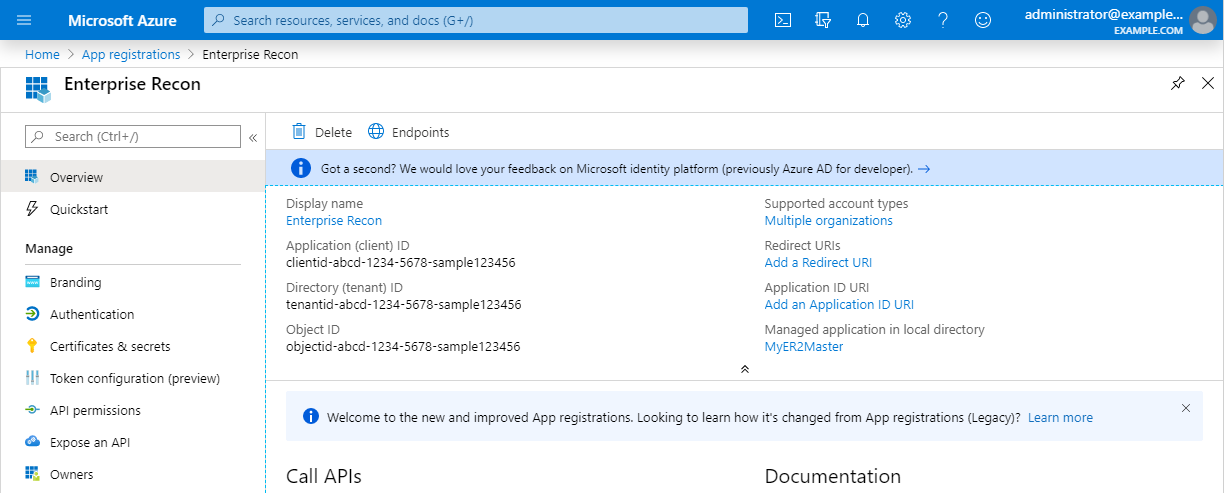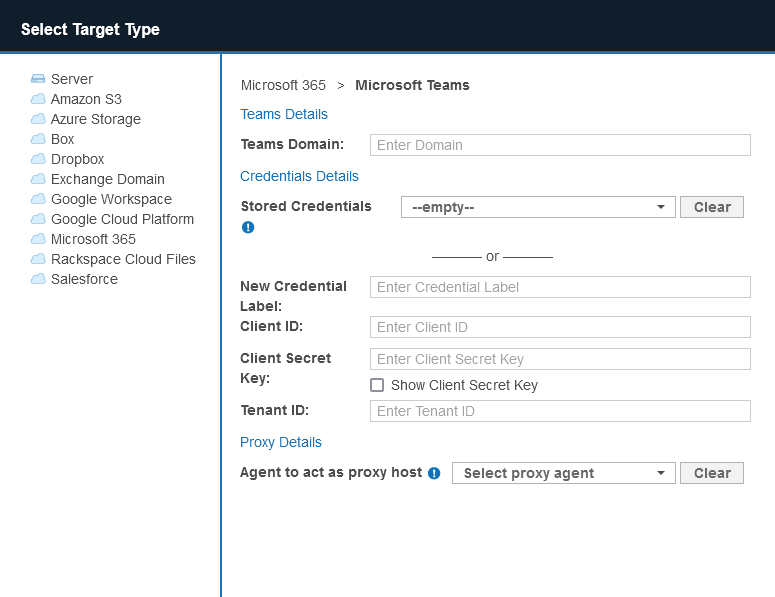Enterprise Recon 2.13.0
Microsoft Teams
This section covers the following topics:
- Overview
- Licensing
- Requirements
- Configure Microsoft 365 Account
- Set Up and Scan a Microsoft Teams Target
- Edit Microsoft Teams Target Path
- Unsupported Types and Folders in Microsoft Teams
- Microsoft Teams Remediation
- Users in Multiple Groups
Overview
When Microsoft Teams is added as a scan Target, ER2 returns the channel conversations and private chat messages for all Microsoft 365 groups, teams, and user accounts. You can select specific groups, teams, channel conversations or private chat messages sent by individual users when setting up the scan schedule. Each team for channel conversations and each group for private chats will be presented as a separate location for the Microsoft Teams Target.
You can also scan the private chat messages sent by all users in your organization's domain by selecting the Private Chats > "All Users" group as a scan location.
Example of Microsoft Teams structure:
Microsoft Teams [domain: example.onmicrosoft.com]
+- Microsoft Teams on target MS365:EXAMPLE.ONMICROSOFT.COM
+- Channels
+- Team A
+- Channel 1
+- Channel 2
+- Team Engineering
+- Channel 1
+- Channel 2
+- Private Chats
+- Group All Users
+- User A
+- User B
+- Group Engineering
+- User B
+- User C
+- Group Design
+- User D
+- User E
Licensing
For Sitewide Licenses, all scanned Microsoft Teams Targets consume data from the Sitewide License data allowance limit.
For Non-Sitewide Licenses, Microsoft Teams Targets require Client Licenses, and consume data from the Client License data allowance limit.
See Target Licenses for more information.
Requirements
| Requirements | Description |
|---|---|
| Proxy Agent |
|
| TCP Allowed Connections | Port 443 |
Configure Microsoft 365 Account
Generate Client ID and Tenant ID Key
- With your administrator account, log in to the Azure app registration portal.
- In the App registrations page, click + New registration.
-
In the Register an application page, fill in the following fields:
Field Description Name Enter a descriptive display name for ER2. For example, Enterprise Recon. Supported account types Select Accounts in this organizational directory only. - Click Register. You will be redirected to the Overview page for the newly registered app, Enterprise Recon.
-
Take down the Application (client) ID and Directory (tenant) ID. This is required when you want to Set Up and Scan a Microsoft Teams Target.

Generate Client Secret Key
- With your administrator account, log in to the Azure app registration portal.
- In the App registrations page, go to the Owned applications tab. Click on the app that you registered (e.g. Enterprise Recon) when generating the Client ID and Tenant ID key.
- In the Manage panel, click Certificates & secrets.
- In the Client secrets section, click + New client secret.
-
In the Add a client secret page, fill in the following fields:
Field Description Description Enter a descriptive label for the Client Secret key. Expires Select a validity period for the Client Secret key. -
Click Add. The Value column will contain the Client Secret key.

-
Copy and save the Client Secret key to a secure location. This is required when you want to Set Up and Scan a Microsoft Teams Target.
Save your Client Secret key in a secure location. You cannot access this Client Secret key once you navigate away from the page.
Grant API Access
To scan Microsoft Teams Targets, you will need to grant ER2 permissions to access specific resource APIs.
- With your administrator account, log in to the Azure app registration portal.
- In the App registrations page, go to the Owned applications tab. Click on the app that you registered (e.g. Enterprise Recon) when generating the Client ID and Tenant ID key.
- In the Manage panel, click API permissions.
- In the Configured permissions section, click + Add a permission.
- In the Request API permissions page, select Microsoft Graph > Application permissions.
-
Select the following permissions for the Enterprise Recon app:
API Permissions Description - Group.Read.All
- User.Read.All
- Directory.Read.All
- ChannelMessage.Read.All
- Chat.Read.All
Required for probing and scanning Microsoft Teams Targets. - Click Add permissions.
- In the Configured permissions page, click on Grant admin consent for <organization name>.
- In the Grant admin consent confirmation dialog, click Yes. The Status column for all the newly added API permissions will be updated to "Granted for <organization name>".
Set Up and Scan a Microsoft Teams Target
This section describes how to set up Microsoft Teams Targets for ER 2.8.0 and above.
- Configure Microsoft 365 Account.
- From the New Scan page, Add Targets.
- In the Select Target Type dialog box, select Microsoft 365 > Microsoft Teams.
-
Fill in the following details:

Field Description Teams Domain Enter the Microsoft 365 domain to scan.
Example: example.onmicrosoft.com
Only accounts where the user principal name (UPN) shares the same domain as specified in the Teams Domain field will be scanned and/or listed when probing the Target.For example, if Teams Domain is set to example.onmicrosoft.com, user1@example2.onmicrosoft.com will not be scanned and/or listed when probing the Target even if the user belongs to a group in the example.onmicrosoft.com domain.
To scan multiple domains within your organization's Microsoft 365 environment, add these domains as separate Microsoft Teams Targets.
New Credential Label Enter a descriptive label for the Microsoft Teams credential set.
Example: m365-microsoftteams-exampledomain
Client ID Enter the Client ID.
Example: clientid-1234-5678-abcd-6d05bf28c2bf
See Generate Client ID and Tenant ID Key for more information.
Client Secret Key Enter the Client Secret key.
Example: client~secret.key-CHvV1B5YQfr~6zDjEyv
See Generate Client Secret Key for more information.
Tenant ID Enter the Tenant ID.
Example: tenantid-1234-abcd-5678-02011df316f4
See Generate Client ID and Tenant ID Key for more information.
Agent to act as proxy host Select a Windows, Linux or macOS Proxy Agent host with direct Internet access.
- Click Test. If ER2 can connect to the Target, the button changes to a Commit button.
- Click Commit to add the Target.
- Back in the New Scan page, locate the newly added Microsoft Teams Target and click on the arrow next to it to display a list of available Microsoft 365 groups for the domain.
- Select the Target location(s) to scan.
-
If "All Users" is selected, ER2 scans all user accounts in the Microsoft 365 domain.
"All Users" is a default, non-configurable virtual group in ER2 that automatically includes all user accounts in the Microsoft 365 domain. If a similar "All Users" group pre-exists in your Microsoft 365 environment, we recommend that you change the display name for that group as it will be viewed as a duplicate group and will not be displayed in ER2. -
If only specific teams or groups are selected, ER2 only scans the channel conversations or private chat messages sent from user accounts in the selected groups.
For Microsoft Teams Target location paths that contain special characters (e.g. "#", "%", "&", etc…), probe the Target to add and scan the location. -
- Click Test. If ER2 can connect to the Target, the button changes to a Commit button.
- Click Commit to add the Target.
-
(Optional) On the Select Locations page, probe the Target to browse and select specific Target locations to scan.
- Click Next.
- On the Select Data Types page, select the Data Type Profiles to be included in your scan and click Next.
-
On the Set Schedule page, configure the parameters for your scan. See Set Schedule for more information.
- Click Next.
- On the Confirm Details page, review the details of the scan schedule, and click Start Scan to start the scan. Otherwise, click Back to modify the scan schedule settings.
Edit Microsoft Teams Target Path
- Set Up and Scan a Microsoft Teams Target.
-
In the Select Locations section, select your Microsoft Teams Target location and click Edit.
For Microsoft Teams Target location paths that contain special characters (e.g. "#", "%", "&", etc…), probe the Target instead to add and scan the location. -
In the Edit Microsoft Teams dialog box, enter a (case sensitive) Path to scan. Use the following syntax:
Channel / Chat to Scan Path All channel conversations in a specific team Syntax: c/<Team Display Name>
Example: c/Engineering (SG)
Specific channel conversation in a specific team Syntax: c/<Team Display Name>/<Channel Name>
Example: c/Engineering (SG)/Feature A
All private chats messages sent from all users in a specific group Syntax: p/<Group Display Name>
Example: p/Engineering (SG)
All private chats messages sent from a specific user in a specific group Syntax: p/<Group Display Name>/<User Principal Name>
Example: p/Engineering (SG)/userA@example.onmicrosoft.com
All private chats messages sent from all users Syntax: p/All Users
Example: p/All Users
If there are multiple Microsoft 365 groups with the same display name in your domain, ER2 will only retrieve the first group occurrence. For example, if there are three groups with the same display name, "Engineering", ER2 will only probe, scan and return results for the first "Engineering" group for the Microsoft Teams Target. - Click Test and then Commit to save the path to the Target location.
Unsupported Types and Folders in Microsoft Teams
ER2 does not support the following types and folders for the Microsoft Teams Target:
- Calendar. To scan the Calendar folder, set up and scan the Exchange Online Target instead.
- Contacts. To scan the Contacts folder, set up and scan the Exchange Online Target instead.
- Attachments (e.g. files, videos etc…) sent in channel conversations and private chat messages. To scan these attachments, set up and scan the OneDrive Business or SharePoint Online Target instead.
- (Calls) History.
Microsoft Teams Remediation
The following remediation actions are supported for Microsoft Teams Targets:
Users in Multiple Groups
This section describes the behavior of users that are members of multiple groups for the Microsoft Teams Target.
License Consumption
A private chat message sent from a user account that belongs to multiple groups
- is scanned each time a group the user belongs to is scanned.
- consumes only 1x data allowance usage regardless of how many times it is scanned as part of different groups.
When both "Engineering" and "Design" groups are added to the same scan, the private chat messages sent by "UserA" are scanned once when "Engineering" is scanned, and a second time when "Design" is scanned.
"UserA" consumes only one Client License, and 5 MB Client License data allowance despite having been scanned twice.
Scan Results
Matches that are found in private chat messages sent by users that belong to multiple groups will be reported as a distinct match count for each group.
Take for example a simplified Microsoft Teams Target for the domain "example.onmicrosoft.com" below:
EXAMPLE.ONMICROSOFT.COM 55 matches
+– Engineering 30 matches
+– UserA 10 matches
+– UserB 20 matches
+– Design 25 matches
+– UserA 10 matches
+– UserC 15 matches
Matches found in private chat messages sent by "UserA" will be included in the match count for both Engineering and Design groups.
PRO This feature is only available in Enterprise Recon PRO Edition. To find out more about upgrading your ER2 license, please contact Ground Labs Licensing. See Subscription License for more information.